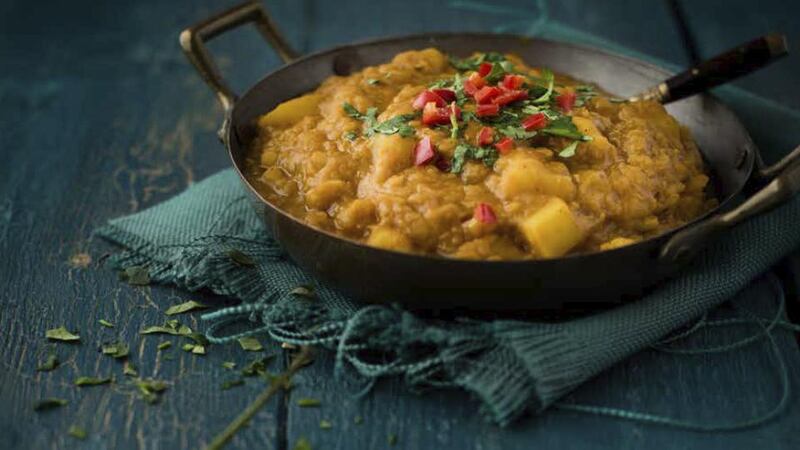One fateful evening in 2007, Atoosa Sepehr was out with friends in her home town of Isfahan in central Iran, saying goodbye as she prepared to leave for a new job and a new life in the UK. The social gathering was interrupted by a phone call from her estranged husband, who informed her of his intention to prevent her from leaving the country.
“I called my mum and dad and they said get back home quickly. So I went back, packed my stuff, and we drove to Tehran, a seven-hour drive. We went straight to the airport. I was so lucky, there was a flight the same night to London. The next morning, he banned me from leaving the country.”
It wasn’t easy for her in those first days, weeks and months in London, she says. “Going to a country knowing that you’re going back [home] is one thing, but going and knowing you’re not going back, you’re going to stay . . .”
In the period that followed her dramatic escape, Sepehr took refuge in the familiar, cooking dishes that reminded her of the home and the family from which she was separated. “Food was really important to me. When I was feeling lonely, missing my family, I cooked. I was calling my mum and my aunts, asking for recipes.”
First cookbook
Now divorced and living between London and Dublin with her Irish partner, Sepehr has put those dark days behind her. The former software engineer turned steel industry consultant and accountant, has just published her first cookbook, a compendium of Persian family recipes.
It is a beautifully produced and authoritative work, illustrated with stunning food photographs that Sepehr styled and shot herself. The images have the careful composition and appearance of still life paintings. It is all the more impressive when the author tells me that she began the project with no knowledge of photography.
Originally, her partner, who is a lecturer and professional photographer, was to shoot the book, “but he was doing his PhD and didn’t really have much time, so he spent an hour with me going through the technical things about the camera”.
Undaunted, Sepehr set up a studio in their home, scoured skips for pieces of distressed wood to turn into backdrop boards, and filled a whole room with props. “I was cooking in the morning, running with the food, before it got cold, to the studio, and taking the shots.”
Creativity
Having moved on from the steel import/export company that brought her to the UK, Sepehr became an accountant, but she took a break from business to work on the book. “Sometimes in life you get to a point where you want to do something that you really like, and always wanted to do, but never had the chance to do, and for me it was [bringing out] my creative side.”
She also wanted, in writing the book, to promote Iranian food and culture, “and show the other side of Iran because all we hear is the bad news”. She now returns to Iran once or twice a year to visit her parents, who still live in Isfahan. “It is a beautiful country, and I miss the people. I go [there] with my friends and they are amazed, because when people see you are a foreigner, they come to you and say, ‘Why don’t you come to my home, or have you been here? Would you like me to take you? Have you done this?’”
She says that food, and hospitality, are at the core of life in her country of birth. “I remember when I took my friend, my brother said to him, ‘The first thing you need to remember when you go to somebody’s home in Iran and you are invited for lunch or dinner, is never empty your plate. Because as soon as you empty it, they’re going to fill it up again.’ ”
She and her partner plan to move to live in Ireland full-time in the next year or so, and she has been getting to grips with life here. “I love the humour in Ireland, you know, the slagging. In the beginning, I wasn’t getting the slagging and I was quite defensive. It was like . . . ‘Atoosa, we’re slagging, you need to learn.’ I am getting much better at it now.”
From a Persian Kitchen: Authentic Recipes and Fabulous Flavours from Iran, by Atoosa Sepehr, is published by Robinson, £26

PERSIAN DAL (DAL ADAS)
Persian dal, a vegetarian dish, is easy to make and very tasty. Although it looks a little like Indian dhal, the combination of ingredients is quite different. Dal Adas originated in the city of Bushehr in the south of Iran, on the Persian Gulf. It is usually served with Persian rice.
Serves four
Ingredients
3 tbsp vegetable or light olive oil
3 large onions, finely chopped
1 large bulb of garlic, cloves separated and crushed
½tbsp ground turmeric
½tsp ground cumin
¼tsp ground cinnamon
200g red lentils, rinsed
750ml vegetable stock
1 large potato (about 250g), peeled and chopped into roughly 1cm cubes
30g tomato purée
2tbsp fresh lime juice
¼-1tsp chilli powder
Salt
Chopped fresh coriander and red chilli to garnish (optional)
Method
1 Add the oil and onions to a large pan on a medium heat and fry for 10-12 minutes, stirring occasionally, until soft and beginning to turn golden brown.
2 Add the garlic and cook for 3 minutes, stirring constantly.
3 Add the turmeric, cumin and cinnamon and stir for 30 seconds before adding the lentils and mixing well.
4 Add the stock, stir, and bring to the boil. Reduce the heat to the lowest setting, cover with a lid and simmer for 15 minutes.
5 Add the potatoes, give it a good stir, put the lid back on and cook for a further 20-25 minutes or until the potatoes are tender, stirring every now and then to prevent the ingredients from sticking to the bottom of the pan.
6 Add the tomato purée, lime juice and chilli powder to taste and stir well. Taste and add salt if needed. Cook on a medium heat for a couple of minutes without the lid (if the texture is too thick, add a little boiling water). Scatter over some chopped coriander and chilli, if using, and serve.

POMEGRANATE SOUP WITH MEATBALLS (ASH-E ANAR)
In Iran, people generally use sour pomegranate juice to make this soup. In this recipe I use sweet pomegranate juice combined with pomegranate molasses to give a sweet and sour taste. If you prefer it sweeter, add a little honey at the end. The fried mint topping gives this soup a wonderful flavour. For a vegetarian version, omit the meatballs and use vegetable stock instead.
Serves six
Ingredients
50g fresh flat-leaf parsley
50g fresh coriander
40g fresh mint leaves
60g fresh chives (or the green part of spring onions)
3tbsp olive oil
3 large onions, finely chopped
½tbsp ground turmeric
1tsp ground cumin
1tsp ground cinnamon
40g basmati rice, rinsed
80g dried yellow split peas, rinsed
60g pearl barley, rinsed
1 litre meat stock
1 litre pomegranate juice
100ml pomegranate molasses
Salt
For the meatballs
300g minced lamb (up to 20% fat)
1 onion, coarsely grated
1tsp ground turmeric
½tsp ground cumin
½tsp ground cinnamon
¼tsp freshly ground black pepper
½tsp salt
For the toppings
Fried mint
3 onions for crispy fried onion (optional)
Pomegranate seeds (optional)
Method
1 Finely chop all the herbs, either by hand or in a food processor (do not overchop them in the processor), and set aside.
2 In a large heavy based pan, add the olive oil and onions, stir to mix, and cook on a medium heat for 20 minutes until caramelised (do not rush this stage as the cooked onions form the base of the soup); stir occasionally at first and more frequently as the onions begin to change colour to prevent them from burning.
3 Add the turmeric, cumin and cinnamon, stir for 30 seconds, then add the rice, split peas, barley and stock. Bring to the boil, then turn the heat to the lowest setting, put the lid on and simmer for 40 minutes.
4 Meanwhile, make the meatballs: add all the ingredients to a large bowl and knead with your hand until evenly mixed, then shape into small meatballs (about 2-3cm in diameter). Set aside.
5 Add the chopped herbs, pomegranate juice and pomegranate molasses to the soup pan and stir well until fully mixed. Bring to the boil, add the meatballs, bring back to the boil and then turn the heat to the lowest setting, put the lid on and simmer for 50 minutes. Taste and adjust the seasoning if needed.
6 Cook for a further 3 minutes on a medium heat without the lid.
7 While the soup is simmering, make the toppings and set aside. To serve, garnish the soup with the fried mint topping, and crispy fried onion if using, and scatter over some pomegranate seeds if you like.

LATIFEH
This is one of my favourite sweets, which I first had in Tabriz, a city in the northwest of Iran where I studied for several years. It is called latifeh, which means delicacy in Farsi, which makes sense because this dessert is as light as a feather. You will need a piping bag.
Ingredients
40g shelled pistachios
3 large eggs, separated
90g icing sugar, plus extra for dusting
6 cardamom pods, seeds removed and ground to a fine powder
½tbsp vanilla extract
70g self-raising flour
25g cornflour
For the cream filling
300ml double cream
2tsp icing sugar
¼tsp rose water
Method
1 Preheat the oven to 220°C/ 200°C fan/Gas 7 and line a baking sheet with baking parchment.
2 Finely grind the pistachios in a food processor. Set aside.
3 Using an electric mixer on a medium speed, whisk the egg whites with half of the icing sugar until the mixture is glossy and stands up in stiff peaks when the beaters are lifted, do not overdo it. Add the ground pistachios and whisk for a further 30 seconds.
4 Set aside. Place the egg yolks in a separate bowl and add the remaining icing
sugar, ground cardamom and vanilla. Using an electric mixer, whisk on a high speed until the mixture is very pale, has tripled in volume and falls in thick ribbons when you lift the beaters (be careful it does not get too thick and firm).
5 Gently fold the egg yolk mixture into the beaten egg whites in two batches. Do not over-fold it as you need to keep the air in the mixture. Mix the flour and cornflour in a bowl and then sift over the egg mixture in two batches and gently fold in. Transfer the mixture to a piping bag. With the bag held vertically, pipe 4-5cm diameter circles onto the lined tin, about 2cm apart.
6 Bake for 6-8 minutes or until the pastries are golden (check frequently as they burn easily). Set aside to cool completely.
7 While the pastries are cooling, prepare the filling. Place all the filling ingredients in a bowl and whisk until thick peaks form. Once cool, sandwich the pastries together with the whipped cream and chill in the fridge for a couple of hours. To serve, dust some icing sugar on top.









